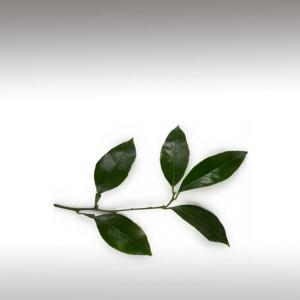
PETITGRAIN ESSENTIAL OIL (CITRUS AURANTIUM) - ESSENTIAL OILS

BASE / GENERAL DATA
Information submited: April 16, 2015 Modified: March 15, 2018 By: OperaDreamhouse
Botanical Name: Citrus aurantium
Common Method of Extraction: Steam distillation
Part Typically Used: Leaves and green twigs
Color: Pale yellow to amber
Consistency: Watery in viscosity
Perfumery Note: Top
Strength of Initial Aroma: Greenish woody orange smell
Though distilled from the same botanical species as Neroli and Bitter Orange, Petitgrain essential oil possesses its own characteristically unique aroma.
Petitgrain essential oil is distilled from the leaves and sometimes the twigs and branches of the tree whereas Neroli essential oil is distilled from the blossoms and Orange essential oil is typically cold pressed from the rinds of the fruits.
Its main regions of production are Paraguay and France, with the former's product being of higher odour tenacity. Petitgrain oil (little grain) gains its name from the fact that it used to be extracted from the small unripe Oranges of the plant.
Thisessential oil is less floral and less citrusy than Neroli or Orange. It has a beautiful, fresh, woody aroma that blends well with the other citrus oils.
Bitter Orange belongs to the Rutaceae family and is believed to have originated in South - East Asia, and spread to North - Eastern India, Burma and China, eventually finding its way via Arab traders to Africa, Arabia and Syria.
From these regions it was taken to the Mediterranean by the Moors and the Crusaders, and by the end of the 12th century it was cultivated in Seville, Spain, thereby leading to the common name for Bitter Oranges "Seville Oranges". This species was also the first "orange" to reach the New World thanks to the second voyage of Christopher Columbus in 1493.
Grasse in the south of France was once well - known for the large quantities of high-quality oil coming from its distilleries. Petitgrain oil was particularly rich in olfactives, and was used for high - quality perfumes and cosmetics of all sorts. The Grasse industry has since diminished, and the main producer now is Paraguay.
Other than in Paraguay, bitter orange trees are cultivated for the production of Petitgrain essential oil in Algeria, Egypt, France, Guinea, Haiti, Italy, Morocco, Spain and Tunisia.
All Citrus oils are very difficult to preserve, so store in dark bottles, cork very carefully, and keep in the dark. Only buy when they are fresh.
The Bitter Orange tree is a small evergreen that reaches a height of about 3 metres in cultivation, but may attain up to 6 metres when growing in the wild. It has a smooth brown trunk with stout branches, and when compared to the Sweet Orange tree (Citrus Dulcis) it has a tighter crown of leaves and more erect stature. The twigs are flexible with rather blunt thorns, and leaves are broad-ovate, glossy and highly aromatic.The green twigs contain a significant amount of essential oiland it is these, along with the aromatic leaves that are used as the source material for Petitgrain essential oil.
Chemical structure:
The main constituents of Petitgrain oil are geraniol, geranyl acetate, linalool, linalyl acetate, myrcene, nerol, neryl acetate, and terpineol.
Common Method of Extraction: Steam distillation
Part Typically Used: Leaves and green twigs
Color: Pale yellow to amber
Consistency: Watery in viscosity
Perfumery Note: Top
Strength of Initial Aroma: Greenish woody orange smell
Though distilled from the same botanical species as Neroli and Bitter Orange, Petitgrain essential oil possesses its own characteristically unique aroma.
Petitgrain essential oil is distilled from the leaves and sometimes the twigs and branches of the tree whereas Neroli essential oil is distilled from the blossoms and Orange essential oil is typically cold pressed from the rinds of the fruits.
Its main regions of production are Paraguay and France, with the former's product being of higher odour tenacity. Petitgrain oil (little grain) gains its name from the fact that it used to be extracted from the small unripe Oranges of the plant.
Thisessential oil is less floral and less citrusy than Neroli or Orange. It has a beautiful, fresh, woody aroma that blends well with the other citrus oils.
Bitter Orange belongs to the Rutaceae family and is believed to have originated in South - East Asia, and spread to North - Eastern India, Burma and China, eventually finding its way via Arab traders to Africa, Arabia and Syria.
From these regions it was taken to the Mediterranean by the Moors and the Crusaders, and by the end of the 12th century it was cultivated in Seville, Spain, thereby leading to the common name for Bitter Oranges "Seville Oranges". This species was also the first "orange" to reach the New World thanks to the second voyage of Christopher Columbus in 1493.
Grasse in the south of France was once well - known for the large quantities of high-quality oil coming from its distilleries. Petitgrain oil was particularly rich in olfactives, and was used for high - quality perfumes and cosmetics of all sorts. The Grasse industry has since diminished, and the main producer now is Paraguay.
Other than in Paraguay, bitter orange trees are cultivated for the production of Petitgrain essential oil in Algeria, Egypt, France, Guinea, Haiti, Italy, Morocco, Spain and Tunisia.
All Citrus oils are very difficult to preserve, so store in dark bottles, cork very carefully, and keep in the dark. Only buy when they are fresh.
The Bitter Orange tree is a small evergreen that reaches a height of about 3 metres in cultivation, but may attain up to 6 metres when growing in the wild. It has a smooth brown trunk with stout branches, and when compared to the Sweet Orange tree (Citrus Dulcis) it has a tighter crown of leaves and more erect stature. The twigs are flexible with rather blunt thorns, and leaves are broad-ovate, glossy and highly aromatic.The green twigs contain a significant amount of essential oiland it is these, along with the aromatic leaves that are used as the source material for Petitgrain essential oil.
Chemical structure:
The main constituents of Petitgrain oil are geraniol, geranyl acetate, linalool, linalyl acetate, myrcene, nerol, neryl acetate, and terpineol.

SPIRITUAL PRACTISES DATA

MEDICINE / HEALTH DATA
Information submited: April 16, 2015 Modified: March 15, 2018 By: OperaDreamhouse
Children: avoid topical use on children under 2.

BEAUTY / COSMETICS DATA

FOOD / COOKING DATA
COMMENTS
No comments.


